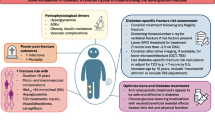Abstract
Background
With the identification of hyperhomocysteinemia as a risk factor for developing osteoporosis, the contribution of thiols metabolically linked with homocysteine (tHcy) may be of importance. Cysteine (Cys) is formed from tHcy and is involved in bone metabolism via incorporation into collagen and cysteine protease enzymes.
Methods
We investigated the association of plasma Cys and related thiols, the bone turnover markers C-telopeptide (CTX) and procollagen type 1 N propeptide (P1NP) and folate and vitamin B6 with calcaneal bone mineral density (BMD) in 328 postmenopausal British women grouped according to their BMD measurement.
Results
Subjects with low BMD had a significantly lower plasma Cys concentration (146.3 vs. 177.7 μmol/l, p < 0.0001), a significantly higher recent fracture rate (30.9% vs. 16.4%, p = 0.017), and a significantly higher percentage of current smokers (26.4% vs. 7.3%. p = 0.003) than those with normal BMD. Additionally, they had a significantly lower plasma Cys, and higher plasma tHcy and CTX, than those with osteopenia. In the whole population, Cys was significantly associated with BMD, weight, height, smoking habit, log creatinine, Cys-Gly, log tHcy, and log folate, but the significant positive association of Cys with BMD was maintained after correction for all other variables (r = 0.197, p = 0.003). After weight, Cys was the next most significant predictor of BMD in a stepwise multiple linear regression model.
Conclusion
Our study suggests a significant association between plasma Cys and BMD. A reduced Cys concentration, possibly modulated by smoking, or reduced flux from tHcy, may lead to reduced availability for collagen formation. Increased osteoclast activation, possibly as a result of relative hyperhomocysteinemia, may lead to increased Cys utilization in cysteine proteases.
Similar content being viewed by others
References
Hermann M, Widmann T, Herrmann W (2005) Homocysteine: A newly recognized risk factor for osteoporosis. Clin Chem Lab Med 43:1111–1117
Ingenbleek Y, Young VR (2004) The essentiality of sulfur is closely related to nitrogen metabolism; a clue to hyperhomocysteinaemia. Nutr Res Rev 17:135–151
Ueland PM (1995) Homocysteine species as components of plasma redox thiol status. Clin Chem 41:340–342
van Meurs JBJ, Dhonukshe-Rutten RAM, Pluijm SMF, van der Klift M, de Jonge R, Lindemans J, de Groot LCPGM, Hofman A, Witteman JCM, van Leeuwen JPTM, Breteler MMB, Lips P, Pols HAP, Uitterlinden AG (2004) Homocysteine levels and the risk of osteoporotic fracture. N Engl J Med 350:2033–2041
McLean RR, Jacques PF, Selhub J, Tucker KL, Samelson EJ, Broe KE, Hannan MT, Cupples LA, Kiel DP (2004) Homocysteine as a predictive factor for hip fracture in older persons. N Engl J Med 350:2042–2049
Baines M, Kredan M-B, Usher J, Davison A, Higgins G, Taylor W, West C, Fraser WD, Ranganath LR (2007) The association of homocysteine and its determinants MTHFR genotype, folate, vitamin B12 and vitamin B6 with bone mineral density in post-menopausal British women. Bone 40:730–736
Yardim-Akaydin S, Ozkan Y, Ozkan E, Torun M, Simsek B (2003) The role of plasma thiol compounds and antioxidant vitamins in patients with cardiovascular diseases. Clin Chim Acta 338:99–105
El-Khairy L, Ueland PM, Nygard O, Refsum H, Vollset SE (1999) Lifestyle and cardiovascular disease risk factors as determinants of total cysteine in plasma: The Hordaland Homocysteine Study. Am J Clin Nutr 70:1016–1024
Ozkan Y, Ozkan E, Simsek B (2002) Plasma total homocysteine and cysteine levels as cardiovascular risk factors in coronary heart disease. Int J Cardiol 82:269–277
Marcucci R, Brunelli T, Giusti B, Fedi S, Pepe G, Poli D, Prisco D, Abbate R, Gensini GF (2001) The role of cysteine and homocysteine in venous and arterial thrombotic disease. Am J Clin Pathol 116:56–60
Zhang SM, Willett WC, Selhub J, Manson JE, Colditz GA, Hankinson SE (2003) A prospective study of plasma total cysteine and risk of breast cancer. Cancer Epidemiol Biomarkers Prev 12:1188–1193
El-Khairy L, Vollset SE, Refsum H, Ueland PM (2003) Plasma total cysteine, pregnancy complications, and adverse pregnancy outcomes: The Hordaland Homocysteine Study. Am J Clin Nutr 77:467–472
Goodman MT, McDuffie K, Hernandez B, Wilkens LR, Selhub J (2000) Case-control study of plasma folate, vitamin B(12), and cysteine as markers of cervical dysplasia. Cancer 89:376–382
Barr RJ, Adebajo A, Fraser WD, Halsey JP, Kelsey C, Stewart A, Reid DM (2005) Can peripheral DXA measurements be used to predict fractures in elderly women living in the community? Osteoporosis Int 16:1177–1183
Zhang M, Gunter EW, Pfeiffer CM (2001) Evaluation of the Drew Scientific DS30 homocysteine assay in comparison with the Centers for Disease Control and Prevention Reference HPLC method. Clin Chem 47:966–967
El-Khairy L, Ueland PM, Refsum H, Graham IM, Vollset SE (2001) Plasma total cysteine as a risk factor for vascular disease: The European Concerted Action Project. Circulation 103:2544–2559
Sobczak A, Wardas W, Zielinska-Danch W, Pawlicki K (2004) The influence of smoking on plasma homocysteine and cysteine in passive and active smokers. Clin Chem Lab Med 42:408–414
Boddie AM, Steen MT, Sullivan KM, Pasquali M, Dembure PP, Coates RJ, Elsas LJ 2nd (1998) Cystathionine-β-synthase deficiency: Detection of heterozygotes by the ratio of homocysteine to cysteine and folate. Metabolism 47:207–211
Herrmann M, Widman T, Colaianni G, Colucci S, Zallone A, Herrmann W (2005) Increased osteoclast activity in the presence of increased homocysteine concentrations. Clin Chem 51:2348–2353
Koh J-M, Lee Y-S, Kim Y, Kim D, Kim H-H, Park JY, Lee KV, Kim GS (2006) Homocysteine enhances bone resorption by stimulation of osteoclast formation and activity through increased intracellular ROS generation. J Bone Miner Res 21:1003–1011
Acknowledgment
We thank REMEDI for financial support for a large part of this work.
Author information
Authors and Affiliations
Corresponding author
Rights and permissions
About this article
Cite this article
Baines, M., Kredan, MB., Davison, A. et al. The Association Between Cysteine, Bone Turnover, and Low Bone Mass. Calcif Tissue Int 81, 450–454 (2007). https://doi.org/10.1007/s00223-007-9089-y
Received:
Accepted:
Published:
Issue Date:
DOI: https://doi.org/10.1007/s00223-007-9089-y




